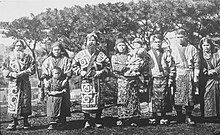Kuril Ainu

Group of Ainu people in Sakhalin Oblast (1902)
|
|
| Total population | |
|---|---|
| 109 (Russian Census 2010) 100 to 1,000 (not federally recognized) |
|
| Regions with significant populations | |
| Sakhalin Oblast, Khabarovsk Krai & Kamchatka Krai | |
| Languages | |
| Russian, Ainu languages | |
| Religion | |
| Russian Orthodox & Shamanism (see Ainu mythology) | |
| Related ethnic groups | |
| Ainu of Hokkaido, Kamchadals, Ryukyuan people,Yamato people |
The Ainu in Russia are an indigenous people of Russia located in Sakhalin Oblast, Khabarovsk Krai and Kamchatka Krai. The Russian Ainu people (Айны), also called Kurile (Куриль), Kamchatka's Kurile (Камчатские Куриль / Камчадальские Айны) or Ein (Ейны), can be subdivided into six groups.
Although only around 100 people currently identify themselves as Ainu in Russia (according to the census of 2010), it is believed that at least 1,000 Russian people are of significant Ainu ancestry. The low numbers identifying as Ainu are a result of the refusal by the federal government to recognise the Ainu as a "living" ethnic group. Most of the people who identify themselves as Ainu live in Kamchatka Krai, although the largest number of people who are of Ainu ancestry (without acknowledging it) are found in Sakhalin Oblast.
Ainu trading expeditions with the Kamchatka Peninsula and other northern regions today part of Russia began very early on, despite the traditionally sedentary customs of Ainu society. Ainu migrations to Kamchatka and the Amur River area from Hokkaido were increasingly limited after the 16th century however, as Japanese merchants and officials increasingly limited their ability to migrate.
The Kamchatka Ainu first came into contact with Russian fur traders by the end of the 17th century. Contact with the Amur Ainu and North Kuril Ainu were established during the 18th century. The Ainu thought the Russians, who differed from their Mongoloid Japanese enemies were their friends and by mid-18th century more than 1,500 Ainu had accepted Russian citizenship. Even the Japanese failed to differentiate between the Ainu and Russian, because of physical similarities (white skin and Caucasoid facial features).
When the Japanese first came into contact with the Russians, they called them Red Ainu (blonde haired Ainu). Only during the beginning of the 19th century did the Japanese learn that the Russians are a different group altogether. The Russians, however, reported the Ainu as "hairy", "swarthy", and with dark eyes and hair. Early Russian explorers reported that the Ainu looked like bearded Russian peasants (with swarthy skin) or like the Roma people.
...
Wikipedia
